
Events 2019
The Interdisciplinary Center for Scientific Computing (IWR) and its affiliated institutions organize a large number of workshops, conferences and other events for discussing latest scientific results as well as identifing upcoming challenges in the field of Scientific Computing. In addition the IWR regularly hosts events which emphasis on broadening and improving the interdisciplinary dialogue.
2019
[January][February][March][April][May][June][July] [August] [September] [October] [November][December]
December
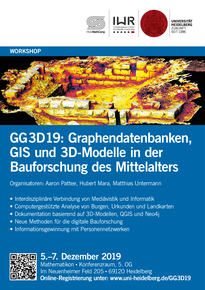
Workshop
"Graphendatenbanken, GIS und 3D-Modelle in der Bauforschung des Mittelalters (GG3D19)"
Organisatoren: Aaron Pattee, Dr. Hubert Mara, Prof. Matthias Untermann
5. bis 7. Dezmeber 2019
Themen:
- Automatic methods for 3D geospatial data processing
- Geographic applications of 3D data analysis
- Hands-on: 3D point cloud and mesh analysis
- Programming and research challenge: Development of computational methods for 3D information extraction
Eingeladene Referenten:
- Dr.-Ing. Vincent Christlein, Universität Erlangen-Nürnberg
- Irmela Herzog, LVR-Amt für Bodendenkmalpflege im Rheinland, Bonn
- Prof. Dr. Stephan Hoppe, Department Kunstwissenschaften an der Universität München
- Alexander C. Q. Jansen, Digital Archaeology, Leiden University
- Dr. Alexy Karenowska, The Institute for Digital Archaeology at Oxford
- Dr. Andreas Kuczera, Akademie der Wissenschaften und der Literatur, Mainz
- Prof. Dr. Piotr Kuroczyński, Hochschule Mainz
- Prof. Dr. Sander Münster, TU Dresden / Universität Jena
- Martina Trognitz, Österreichische Akademie der Wissenschaften / ZAW & FCGL, IWR, Universität Heidelberg
! Registrierung benötigt !
Veranstaltungsort: Mathematikon • Konferenzraum / 5. Stock • Im Neuenheimer Feld 205 • 69120 Heidelberg
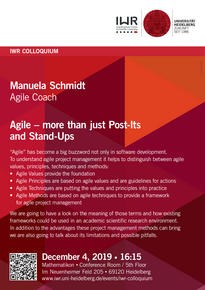
IWR Colloquium Winter Semester 2019/ 2020
"Agile - more than just Post-Its and Stand-Ups"
Manuela Schmidt • Agile Coach
December 4, 2019 • 16:15
"Agile" has become a big buzzword not only in software development. To understand agile project management it helps to distinguish between agile values, principles, techniques and methods:
- Agile Values provide the foundation
- Agile Principles are based on agile values and are guidelines for actions
- Agile Techniques are putting the values and principles into practice
- Agile Methods are based on agile techniques to provide a framework for agile project management
We are going to have a look on the meaning of those terms and how existing frameworks could be used in an academic scientific research environment. In addition to the advantages these project management methods can bring we are also going to talk about its limitations and possible pitfalls.
Location: Mathematikon • Conference Room, Room 5/104, 5th Floor • Im Neuenheimer Feld 205 • 69120 Heidelberg
November
Heidelberg Chapter of SIAM Public Lecture
"Navier-Stokes existence and uniqueness: how to win a $1 million Clay prize"
Prof. David Silvester • University of Manchester
November 27, 2019 • 16:15
In the year 2000, the Clay Mathematics Institute selected seven of the most important open problems in modern mathematics and offered a prize of $1 million for a solution to any of them. Nineteen years on, only one millennium prize problem has been solved. In this talk, Prof. David Silvester will discuss the Navier-Stokes existence and smoothness problem, one of the six remaining unsolved problems.
The Navier-Stokes equations are central to fluid dynamics and its applications to engineering and physics, describing viscous turbulent flow, e.g. of air around an aeroplane wing, weather patterns and blood flow through arteries. Despite the wide-ranging applicability of the Navier-Stokes equations, it is still not known whether they always admit smooth solutions, which contain no unphysical "blow-ups", or singularities.
Location: Mathematikon • Conference Room, Room 5/104, 5th Floor • Im Neuenheimer Feld 205 • 69120 Heidelberg
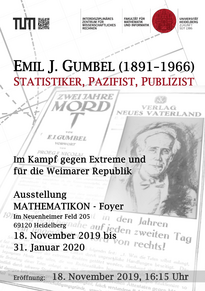
Ausstellungseröffnung
Emil J. Gumbel (1891 – 1966)
Statistiker, Pazifist, Publizist
"Im Kampf gegen Extreme und für die Weimarer Republik"
Montag, 18. November 2019 • 16:15
Emil Julius Gumbel verband mathematische Exzellenz und gesellschaftliche Courage. Als weltbekannter Mathematiker legte er die Grundlagen der Extremwertstatistik. Zugleich setzte er sich in der „Deutschen Liga für Menschenrechte“ gegen Kriegsverherrlichung und die aufkommende NS-Bewegung ein. Die Universität Heidelberg, an der er seit 1923 Dozent war, entzog ihm 1932 die Lehrerlaubnis. 1933 wurde ihm die deutsche Staatsbürgerschaft aberkannt. Die Ausstellung zeigt anhand historischer Dokumente wichtige Lebensstationen und berühmte Weggefährten im Leben Gumbels.
Website Ausstellung Universität Heidelberg
Website Ausstellung TU München
Veranstaltungsort: Mathematikon • Atrium • Im Neuenheimer Feld 205 • 69120 Heidelberg
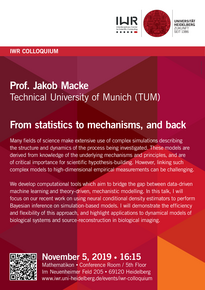
IWR Colloquium Winter Semester 2019/ 2020
"From statistics to mechanisms, and back"
Prof. Jakob Macke • Technical University of Munich (TUM)
November 5, 2019 • 16:15
Many fields of science make extensive use of complex simulations describing the structure and dynamics of the process being investigated. These models are derived from knowledge of the underlying mechanisms and principles, and are of critical importance for scientific hypothesis-building. However, linking such complex models to high-dimensional empirical measurements can be challenging.
We develop computational tools which aim to bridge the gap between data-driven machine learning and theory-driven, mechanistic modelling. In this talk, I will focus on our recent work on using neural conditional density estimators to perform Bayesian inference on simulation-based models. I will demonstrate the efficiency and flexibility of this approach, and highlight applications to dynamical models of biological systems and source-reconstruction in biological imaging.
References:
D Greenberg, M Nonnenmacher, JH Macke: Automatic Posterior Transformation for likelihood-free Inference, International Conference on Machine Learning (ICML) 2019, arxiv.org/abs/1905.07488
JM Lueckmann, P Goncalves, G Bassetto, K Oecal, M Nonnenmacher, JH Macke: Flexible statistical inference for mechanistic models of neural dynamics, Advances in Neural Information Processing Systems (NeurIPS), 2017, arxiv.org/abs/1711.01861
JM Lueckmann, G Bassetto, T Karaletsos, JH Macke: Likelihood-free inference with emulator networks, Proceedings of The 1st Symposium on Advances in Approximate Bayesian Inference, PMLR 96:32-53, 2019. arxiv.org/abs/1805.09294
A Speiser, S Turaga, JH Macke: Teaching deep neural networks to localize sources in super-resolution microscopy by combining simulation-based learning and unsupervised learning, preprint, arxiv.org/abs/1907.00770
DGT Barrett, AS Morcos, JH Macke: Analyzing artificial and biological neural networks: Challenges with opportunities for synergies?, Current Opinion in Neurobiology, 02 2019
arxiv.org/abs/1810.13373
Location: Mathematikon • Conference Room, Room 5/104, 5th Floor • Im Neuenheimer Feld 205 • 69120 Heidelberg
Workshop
"Molecular Stresses"
Organizers: Frauke Gräter & Isabel Martin • HITS & IWR
November 4-5, 2019
This workshop aims at discussing and devising new and unifying concepts to calculate and understand molecular stresses in complex materials. Such molecular stresses can stem from quantum chemical calculations, atomistic or coarse-grained Molecular Dynamics simulations. They could be inherent to the system, i.e. reflect intrinsic tension or pre-stress, or build up upon applying external mechanical perturbations.
In an informal workshop we will bring together experts from the relevant scientific areas, computational physics, materials science, and biological matter, and will leave room for a few contributed talks from participants as well as many discussions among speakers and participants. There is the possibility to participate in a small practical workshop on force distribution analysis (FDA).The workshop is completely free of charge e.g. no registration or conference fees.
Location: Heidelberg Institute for Theoretical Studies (HITS) • Schloss-Wolfsbrunnenweg 35 • 69118 Heidelberg
September
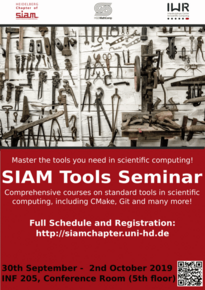
Heidelberg Chapter of SIAM
"SIAM Tools Seminar"
September 30 - October 2, 2019 • Heidelberg, Germany
In cooperation with the MathPhysInfo student representatives the Heidelberg Student Chapter of SIAM organizes a “Tools Seminar” from the 30.09-02.10. The Tools Seminar provides an opportunity for scientists and students to get proficient information about certain tools useful for their study or research and to exchange their experience and knowledge about those tools with colleagues and fellow students. The term "tool" is understood in a broad sense ranging from tools useful when developing software to more general issues like how to give a good presentation.
Everybody is welcome to participate!
However, the Tools Seminar is particularly tailored for Master and PhD Students.
Particularly, the aim of the Tools Seminar is to provide profound information which go beyond the basic concepts that many people might already be familiar with. But each talk will also include at least a short introduction to allow the participants to learn about tools they might not have used before. So, no matter which level of experience you have with the tools presented, you should be able to learn something new in this seminar!
Location: Mathematikon • Im Neuenheimer Feld 205 • Conference Room / 5th Floor • 69120 Heidelberg
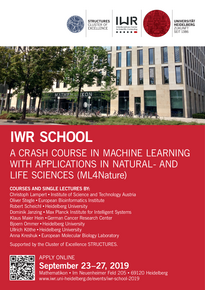
IWR School
"A Crash Course in Machine Learning with Applications in Natural- and Life Sciences (ML4Nature)"
September 23-27, 2019 • Heidelberg, Germany
The IWR School 2019 gives a crash course in machine learning with applications from Natural Sciences and Life Sciences. We target young researchers from Natural Sciences and Life Sciences who want to learn more about machine learning. A background in machine learning is not required. Besides introducing the basic concepts of machine learning, we teach selected topics in more depth, such as deep learning, metric learning, transfer learning, Bayesian inverse problems, and causality. Experts from machine learning, Natural Science and Life Science explain how these machine learning approaches are utilized to solve problems in their respective fields of research.
Target Audience
Postgraduate students, PhD candidates, postdocs and young researchers:
- from Natural and Life Sciences: Microscopy, Biology, Medical, Physics,…
- with interest in Machine Learning
- Master students from Heidelberg University (core course listed in LSF)
Speakers
The IWR School 2019 is taught in a series of courses and single lectures by:
- Christoph Lampert, Institute of Science and Technology Austria
- Oliver Stegle, European Bioinformatics Institute
- Robert Scheichl, Heidelberg University
- Dominik Janzing, Max Planck Institute for Intelligent Systems
- Klaus Maier Hein, German Cancer Research Center
- Bjoern Ommer, Heidelberg University
- Ullrich Köthe, Heidelberg University
- Anna Kreshuk, European Molecular Biology Laboratory
! Registration required ! (Deadline: July 7, 2019)
The IWR School 2019 is supported by the Cluster of Excellence STRUCTURES.
Location: Mathematikon • Im Neuenheimer Feld 205 • 69120 Heidelberg
July
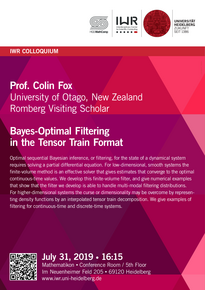
IWR Colloquium Summer Semester 2019
"Bayes-Optimal Filtering in the Tensor Train Format"
Prof. Colin Fox, Romberg Visiting Scholar • University of Otago, New Zealand
July 31, 2019 • 16:15
Optimal sequential Bayesian inference, or filtering, for the state of a dynamical system requires solving a partial differential equation. For low-dimensional, smooth systems the finite-volume method is an effective solver that gives estimates that converge to the optimal continuous-time values. We develop this finite-volume filter, and give numerical examples that show that the filter we develop is able to handle multi-modal filtering distributions. For higher-dimensional systems the curse or dimensionality may be overcome by representing density functions by an interpolated tensor train decomposition. We give examples of filtering for continuous-time and discrete-time systems.
Location: Mathematikon • Conference Room, Room 5/104, 5th Floor • Im Neuenheimer Feld 205 • 69120 Heidelberg
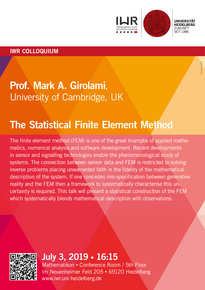
IWR Colloquium Summer Semester 2019
"The Statistical Finite Element Method"
Prof. Mark A. Girolami • University of Cambridge, UK
July 3, 2019 • 16:15
The finite element method (FEM) is one of the great triumphs of applied mathematics, numerical analysis and software development. Recent developments in sensor and signalling technologies enable the phenomenological study of systems. The connection between sensor data and FEM is restricted to solving inverse problems placing unwarranted faith in the fidelity of the mathematical description of the system. If one concedes mis-specification between generative reality and the FEM then a framework to systematically characterise this uncertainty is required. This talk will present a statistical construction of the FEM which systematically blends mathematical description with observations.
Location: Mathematikon • Conference Room, Room 5/104, 5th Floor • Im Neuenheimer Feld 205 • 69120 Heidelberg
Workshop
"Uncertainty Quantification, Machine Learning & Bayesian Statistics in Scientific Computing"
Prof. Robert Scheichl • IWR
July 1-5, 2019
Scientific computing concerns the development of mathematical models and high-performance software able to describe, simulate and learn the behaviour of complex phenomena. Applications can arise from any area of applied sciences (e.g. engineering, physics, biology, chemistry) and typically retain the challenging task of quantifying high-dimensional uncertainty due to known unknowns and unknown unknowns present in the natural system. When this is added to the computational burden of approximating and solving complex mathematical models, the application of standard inference algorithms, e.g. for parameter estimation, prediction or optimization, becomes quickly unfeasible within a reasonable computational budget.
The aim of the workshop is to bring together researchers working in Uncertainty Quantification, Machine Learning and Bayesian Statistics with a particular focus on high- and infinite-dimensional problems from scientific computing, where the sparsity or uncertainty of data requires an integration of inference and learning algorithms with established physical models, such as partial differential equations. Advances in this complex field of research require a concerted effort from many disciplines, which we hope to foster at the workshop.
This workshop is part of the Thematic Semester Uncertainty Quantification, Machine Learning & Bayesian Statistics in Scientific Computing at MAThematics Center Heidelberg (MATCH) in conjunction with the Excellence Cluster STRUCTURES. The financial support from MATCH and from the Heidelberg Graduate School of Mathematical and Computational Methods for the Sciences (HGS MathComp) is gratefully acknowledged.
Registration required!
Location: Mathematikon • Im Neuenheimer Feld 205 • 69120 Heidelberg
June

Symposium
"Moderne Methoden in der Wissenschaftlichen Visualisierung"
Fakultät für Mathematik und Informatik & Interdisziplinäres Zentrum für Wissenschaftliches Rechnen (IWR)
27. Juni 2019
09:00 Uhr
"Guided Parameter Exploration in Interactive Visualization"
Prof. Stefan Bruckner, University of Bergen, Norway
Over the past decades the field of visualization has firmly established itself as an important and constantly expanding discipline within computer science. Computer-based visualization seeks to provide interactive graphical data representations, taking advantage of the extraordinary capability of the human brain to process visual information. Advanced visualization methods now play an important role in the exploration, analysis, and presentation of data in many fields such as medicine, biology, geology, or engineering. This development, however, has also lead to the fact that there is now a vast number of often very specialized techniques to visualize different types of data tailored towards specific tasks. Hence, particularly for non-experts, it becomes increasingly difficult to choose appropriate methods that will provide the optimal answers to their questions.
In this talk, I will discuss previous and ongoing research on how we can explore and navigate the space of visualizations itself. By consider the interplay between data, visualization algorithms, their parameters, perception, and cognition as a complex phenomenon that deserves study in its own right, we are making progress in providing goal-oriented interfaces for visual analysis. For instance, we can make the modification of input parameters of visualization algorithms more intuitive by normalizing their perceived effects over the entire value range, and provide visual guidance about their influence. Furthermore, by incorporating additional knowledge into the visualization process, we can infer information about the goals of a user, and develop smarter systems that automatically suggest appropriate visualization techniques. This line of investigation leads us along the path towards a new type of visual data science, where automated data analysis approaches such as deep learning are tightly coupled with interactive visualization techniques to exploit their complementary advantages for knowledge discovery in data-driven science.
10:00 Uhr
"Topological and Morphological Analysis of Flow Fields and Beyond"
Prof. Filip Sadlo, Universität Heidelberg
This talk focuses on four active branches in scientific visualization research: topological analysis, feature extraction, volume rendering, and solver visualization. We examine various roles of topological analysis in flow fields and beyond, we investigate feature extraction in higher dimensions and higher order, we extend volume rendering beyond direct geometrical optics, and we extend scientific visualization from the traditional analysis of simulated data to analysis of the numerical solvers that produce the data. On the application side, we discuss the utility of the investigated visualization techniques in the natural and life sciences, and indicate possible directions of future research.
11:00 Uhr
"Insights from the Pixel Dump: Scientific Image Visualization"
Prof. Thomas Schulz, Universität Bonn
Big, complex, and dynamic image data play an increasing role in science and medicine. This poses important and interesting challenges to scientific visualization, since the traditional visual inspection of raw images is no longer a suitable strategy for their effective and efficient interpretation. Instead, mathematical modeling, feature extraction, and machine learning are required to pre-process the data, and to allow the human user to reason about it at a higher level of abstraction. This talk will illustrate these points with several specific examples from diffusion Magnetic Resonance Imaging, as well as image data from ophthalmic epidemiology.
Veranstaltungsort: Mathematikon • Konferenzraum, 5. Stock, Raum 5/104 • Im Neuenheimer Feld 205 • 69120 Heidelberg
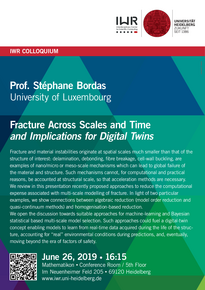
IWR Colloquium Summer Semester 2019
"Fracture Across Scales and Time
and Implications for Digital Twins"
Prof. Stéphane Bordas • University of Luxembourg
June 26, 2019 • 16:15
Fracture and material instabilities originate at spatial scales much smaller than that of the structure of interest: delamination, debonding, fibre breakage, cell-wall buckling, are examples of nano/micro or meso-scale mechanisms which can lead to global failure of the material and structure. Such mechanisms cannot, for computational and practical reasons, be accounted at structural scale, so that acceleration methods are necessary.
We review in this presentation recently proposed approaches to reduce the computational expense associated with multi-scale modelling of fracture. In light of two particular examples, we show connections between algebraic reduction (model order reduction and quasi-continuum methods) and homogenisation-based reduction.
We open the discussion towards suitable approaches for machine-learning and Bayesian statistical based multi-scale model selection. Such approaches could fuel a digital-twin concept enabling models to learn from real-time data acquired during the life of the structure, accounting for “real” environmental conditions during predictions, and, eventually, moving beyond the era of factors of safety.
Location: Mathematikon • Conference Room, Room 5/104, 5th Floor • Im Neuenheimer Feld 205 • 69120 Heidelberg
Workshop
"PIMS - Germany 2019 Collaborative Research Workshops"
The Pacific Institute for the Mathematical Sciences (PIMS) & Heidelberg University
June 24-26, 2019
PIMS, in collaboration with partners at Heidelberg University, will be hosting two parallel workshops on Discretization of Variational Eigenvalue Problems and Modeling and Analysis of PDEs for Biological Applications. These workshop will identify common research interests and establish new research collaborations on specific projects among researchers at PIMS and at Universities in Heidelberg, Munster and Berlin. For more details on these events, please follow the links below.
Workshop on Discretization of Variational Eigenvalue Problems
Organizers: Chen Greif (University of British Columbia), Guido Kanschat (Heidelberg University), Nilima Nigam (SFU), Peter Minev (University of Alberta)
Workshop on Modeling and Analysis of PDEs for Biological Applications
Organizers: Michael Ward (UBC), Anna Marciniak-Czochra (Heidelberg University)
Location: Mathematikon • Im Neuenheimer Feld 205 • 69120 Heidelberg
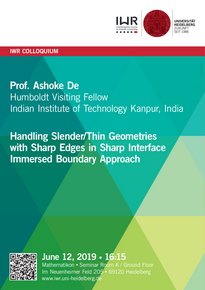
IWR Colloquium Summer Semester 2019
"Handling Slender/Thin Geometries with Sharp Edges in Sharp Interface Immersed Boundary Approach"
Prof. Ashoke De • Humboldt Visiting Fellow • Indian Institute of Technology Kanpur, India
June 12, 2019 • 16:15
Immersed boundary framework offers a viable alternative to traditional body conformal computational models in simulating flow past arbitrarily complex geometries. Over the years various immersed boundary formulations have been proposed which can be broadly classified into two approaches namely ‘diffuse’ and ‘sharp’ interface. As the name suggests, diffuse interface impose boundary conditions not at their exact interface boundary but within a localized region around them. Sharp interface on the other hand overcomes this either by reconstructing the solution field near the surface (as in Ghost Cell method) such that the boundary conditions are imposed exactly at the surface or by reconstituting the boundary intercept cells into a non-rectangular control volume (Cut Cells) on which conservation laws are ensured. A major issue with these class of approaches is its inconsistent handling of sharp edges in slender/thin bodies (as in flat plate, trailing edge of an airfoil). With the Cut Cell approach, sharp edges lead to generation of arbitrarily small cells, complex cut cell topologies. Enforcing conservation laws for such cells give rise to numerical stability issues. In case of solution reconstruction algorithms, the nature of difficulty in handling sharp edges is twofold: One, due to inconsistent tagging of Eulerian nodes. Another difficulty is insufficient number of points to maintain the order of accuracy of flux calculations. Several strategies have been proposed to address these issues. In case of cut cells, cell merging, cell clustering, hybrid of ghost cell and cut cell algorithms are proposed to maintain mass conservation. In case of solution reconstruction schemes, approaches like Adaptive Mesh Refinements (AMR) are proposed. These strategies are highly complex both in terms of their formulation and implementation. In this talk, a simple and robust set of procedures for efficiently handling the sharp edges will be presented. Capability of the algorithm is demonstrated successfully through a case study of dynamic stall in oscillating airfoil.
Keywords: Sharp Interface, Immersed Boundary Method, Dynamic Stall, Sharp edges
Location: Mathematikon • Seminar Room A, Ground Floor • Im Neuenheimer Feld 205 • 69120 Heidelberg
May
Talk
"A Sequential Homotopy Method for Mathematical Programming Problems"
Dr. Andreas Potschka • Interdisciplinary Center for Scientific Computing (IWR)
May 16, 2019 • 14:15
We consider nonconvex and highly nonlinear mathematical programming problems including finite dimensional nonlinear programming problems as well as optimization problems with partial differential equations and control constraints. We present a novel numerical solution method, which is based on a projected gradient/anti-gradient flow for an augmented Lagrangian on the primal/dual variables. We show that under reasonable assumptions, the nonsmooth flow equations possess uniquely determined global solutions, whose limit points (provided that they exist) are critical, i.e., they satisfy a first-order necessary optimality condition. Under additional mild conditions, a critical point cannot be asymptotically stable if it has an emanating feasible curve along which the objective function decreases. This implies that small perturbations will make the flow escape critical points that are maxima or saddle points. If we apply a projected backward Euler method to the flow, we obtain a semismooth algebraic equation, whose solution can be traced for growing step sizes, e.g., by a continuation method with a local (inexact) semismooth Newton method as a corrector, until a singularity is encountered and the homotopy cannot be extended further. Moreover, the projected backward Euler equations admit an interpretation as necessary optimality conditions of a proximal-type regularization of the original problem. The prox-problems have favorable properties, which guarantee that the prox-problems have uniquely determined primal/dual solutions if the Euler step size is sufficiently small and the augmented Lagrangian parameter is sufficiently large. The prox-problems morph into the original problem when taking the step size to infinity, which allows the following active-set-type sequential homotopy method: From the current iterate, compute a projected backward Euler step by applying either local (inexact) semismooth Newton iterations on the step equations or local (inexact) SQP-type (sequential quadratic programming) methods on the prox-problems. If the homotopy cannot be continued much further, take the current result as a starting point for the next projected backward Euler step. If we can drive the step size all the way to infinity, we can transition to fast local convergence. We can interpret this sequential homotopy method as extensions to several well-known but seemingly unrelated optimization methods: A general globalization method for local inexact semismooth Newton methods and local inexact SQP-type methods, a proximal point algorithm for problems with explicit constraints, and an implicit version of the Arrow--Hurwicz gradient method for convex problems dating back to the 1950s extended to nonconvex problems. We close the talk with numerical results for a class of highly nonlinear and badly conditioned control constrained elliptic optimal control problems with a semismooth Newton approach for the regularized subproblems.
Preprint available on arxiv.org/abs/1902.06984.
Location: Mathematikon • Room 2/414, 2nd Floor • Im Neuenheimer Feld 205 • 69120 Heidelberg
April

Compact Course & Workshop
"Spatial and Temporal Analyses of Geographic Phenomena (STAP19)"
Organizers: Katharina Anders, Bernhard Höfle, Hubert Mara
April 1-4, 2019
Topics:
- Automatic methods for 3D geospatial data processing
- Geographic applications of 3D data analysis
- Hands-on: 3D point cloud and mesh analysis
- Programming and research challenge: Development of computational methods for 3D information extraction
Invited speakers:
- Prof. Dr. Andreas Nüchter, University of Würzburg
- Jorge Martínez Sánchez, University of Santiago de Compostela
Registration:
Please register on the website of the Compact Course until February 15, 2019
www.uni-heidelberg.de/stap19
Project Auto3Dscapes:
www.uni-heidelberg.de/auto3Dscapes
Contact: Katharina Anders
katharina.anders@uni-heidelberg.de
Twitter: #STAP19
Location: Mathematikon • Conference Room, 5th Floor • Im Neuenheimer Feld 205 • 69120 Heidelberg
Talk
"Efficiency of Home Radon Mitigation Systems in some Canadian Provinces"
Prof. Motassem Al Arydah • Khalifa University, Department of Mathematics, Abu Dhabi UAE
April 1, 2019 • 11:00
Lung cancer (LC) is the leading cause of death of cancer in Canada in both men and women, and indoor radon is the second leading cause of LC after tobacco smoking. The Population Attributable Risk (PAR) is used to assess radon exposure risk. We use the PAR to identify the radon levels responsible for most LC cases. During the period 2006–2009, 6% of houses in Ontario, 9% of houses in Alberta, 19% of houses in Manitoba, 7% of houses in Quebec, and 5% of houses in British Columbia had radon levels higher than 200 Bq/m3 and was responsible about 913, 211, 260, 972, and 258 lives, respectively. Radon mitigation programs could have prevented these LC cases. We use the PAR function of the two variables, radon action, and target levels, to search for a possible optimal mitigation program. The PAR is a linear function in the target radon value with an estimated slope of 0.0001 for Ontario, Alberta, Quebec, and British Columbia, and 0.0004 for Manitoba. The PAR is an increasing function in the radon action level. The PAR is sensitive to changes in the radon mitigation program and as such, any improvement is a worthwhile investment.
[1] Al-arydah, M. (2018). Estimating the Burden of Lung Cancer and the Efficiency of Home Radon Mitigation Systems in some Canadian Provinces. Science of the Total Environment, 626, , 287-306.
[2] Al-arydah, M. (2017). Population attributable risk associated with lung cancer induced by residential radon in Canada. Sensitivity to relative risk model and radon. Science of the Total Environment. dx.doi.org/10.1016/j.scitotenv.2017.04.067.
Location: Mathematikon • Seminar Room 10, 5th Floor • Im Neuenheimer Feld 205 • 69120 Heidelberg
March
HGS MathComp Von Neumann Lecture
"The Present and Future of Tidy Data"
Dr. Hadley Wickham • Chief Scientist at RStudio, Adjunct Professor at University of Auckland, Stanford and Rice University
March 13, 2019 • 16:15
Tidy data is a standard way of storing your data where columns are variables and rows are observations. Tidy data, particularly when coupled with tidy tools, makes data analysis easier because you can spend less time wrangling the output of one function so that it works as the input for another. Tidy data will make your analysis easier but how you get wild-caught data into a tidy form? In this talk, I'll discuss some of the tools that I have worked on for tidying data (e.g. the tidyr package), the limitations of those tools, and what I'm thinking about next. In particular, I'll discuss a new approach for "pivoting" data, and discuss some of the challenges posed by data stored in hierarchical form (e.g. JSON).
Biography:
Hadley Wickham has pioneered the development of advanced data visualisation and analysis approaches for the R statistical computing platform. He holds a BSc. in Human Biology, and a BSc. and MSc. in Statistics from the University of Auckland. He went on to work with Di Cook and Heike Hofmann at Iowa State University, and obtained his PhD in 2008. In 2007, Hadley released ggplot2 - a data visualisation library based on Leland Wilkinson's 'The Grammar of Graphics', and in 2013, unveiled 'The Tidyverse' - a collection of libraries and methodological approaches for the efficient manipulation of complex data in R. His contributions to the field were recognised in 2008, with his receipt of the John Chambers Award for Statisical Computing, and in 2015, he was made a fellow of the American Statistical Computing Association.
Location: Mathematikon • Conference Room, 5th Floor • Im Neuenheimer Feld 205 • 69120 Heidelberg
February
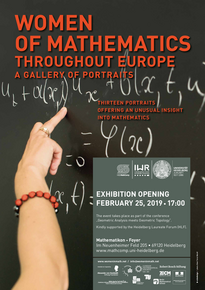
Exhibition Opening
"Women of Mathematics throughout Europe"
February 25, 2019 • 17:00
The event is organized in close cooperation with the conference "Geometric Analysis meets Geometric Topology“.
This touring exhibition, whose starting point is the 7th ECM held in July 2016 in Berlin, stems from the observation that nowadays, women still find it difficult to embrace a career in the mathematical academic world and the disparity between the proportion of men and that of women among professional mathematicians is still shamefully large.
The thirteen women mathematicians portrayed here share with us their experience, thus serving as role models to stimulate young women scientists to trust their own strength. In presenting mathematics through women mathematicians’ perspectives and samples of their life stories, we hope to highlight the human aspects of producing mathematics, making this discipline more tangible and therefore more accessible to outsiders or newcomers.
This exhibition and the catalogue (publishing house: Verlag am Fluss) are the result of the joint efforts of the photographer Noel Tovia Matoff and four mathematicians by Sylvie Paycha, Sara Azzali, Alexandra Antoniouk, Magdalena Georgescu, with the precious help of Maria Hoffmann-Dartevelle, who translated into German and Sara Munday, who proofread the interviews and, last but not least, our two inspired graphic designers Wenke Neunast/eckedesign (exhibition) and Gesine Krüger (catalogue).
The exhibition will be on display from February 26 - May 31, 2019 at the Foyer of the Mathematikon.
The event is kindly supported by the Heidelberg Laureate Forum Foundation (HLFF).
Link: Exhibition Homepage
Location: Mathematikon • Foyer • Im Neuenheimer Feld 205 • 69120 Heidelberg
January

16. Modellierungstag Rhein-Neckar
"Moderne Materialien"
24. Januar 2019 • 14:00 Uhr
Moderne Materialien zählen zu den zentralen Zukunftsthemen in der angewandten Forschung. Die Verwendung hochmoderner Planungsprozesse in den Materialwissenschaften und bahnbrechende Entdeckungen in der Nanoforschung, in der organischen Elektronik und in der computergestützten theoretischen Chemie haben zu einer Revolution geführt. Als eine der Schlüsseltechnologien für das 21. Jahrhundert erlauben die Modernen Materialien einen zielgerichteten Einsatz in zahlreichen Anwendungsgebieten. Durch die Kombination von mehreren Eigenschaften werden immer effektivere Werkstoffe ermöglicht. So können zum Beispiel Stoffe entwickelt werden, die gleichzeitig extrem leicht aber dennoch stabil sind oder wesentlich effizienteren Energietransport erlauben.
Was ist von der Materialforschung in der nächsten Dekade an Entwicklungen noch zu erwarten? Wie wirken hier die unterschiedlichen Forschungsrichtungen zusammen? Und welche Rolle spielt die computergestützte Simulationstechnik bei diesem Paradigmenwechsel von der experimentellen Entwicklung neuer Materialien zur gezielten Planung von Materialeigenschaften am Computer? Mit diesen Fragen beschäftigt sich der 16. Modellierungstag. Wir haben Experten aus Universitäten, Forschung und Produktion eingeladen, um in Impulsvorträgen und praxisnahen Diskussionen die zentralen Fragestellungen aus diesem interdisziplinären Feld zu erörtern.
Der Modellierungstag greift die spannende Frage nach der Zukunft von „Modernen Materialien“ auf und fördert den Austausch zwischen Forschern, Entwicklern, Theoretikern und Anwendern. Beiträge aus unterschiedlichen Fachrichtungen liefern dazu Denkanstöße und Diskussionsgrundlagen.
Veranstaltungsort: Marsilius-Kolleg • Im Neuenheimer Feld 130.1 • 69120 Heidelberg
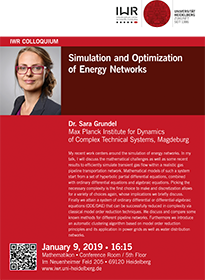
IWR Colloquium Winter Semester 2018 / 2019
"Simulation and Optimization of Energy Networks"
Dr. Sara Grundel • Max Planck Institute for Dynamics of Complex Technical Systems, Magdeburg
January 9, 2019 • 16:15
My recent work centers around the simulation of energy networks. In my talk, I will discuss the mathematical challenges as well as some recent results to efficiently simulate transient gas flow within a realistic gas pipeline transportation network. Mathematical models of such a system start from a set of hyperbolic partial differential equations, combined with ordinary differential equations and algebraic equations. Picking the necessary complexity is the first choice to make and discretization allows for a variety of choices again, whose implications we briefly discuss. Finally we attain a system of ordinary differential or differential-algebraic equations (ODE/DAE) that can be successfully reduced in complexity via classical model order reduction techniques. We discuss and compare some known methods for different pipeline networks. Furthermore we introduce an automatic clustering algorithm based on model order reduction principles and its application in power grids as well as water distribution networks.
Location: Mathematikon • Conference Room (5/300), 5th Floor • Im Neuenheimer Feld 205 • 69120 Heidelberg